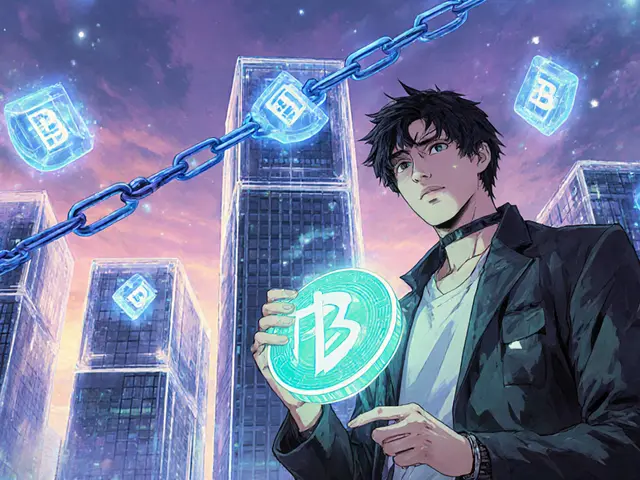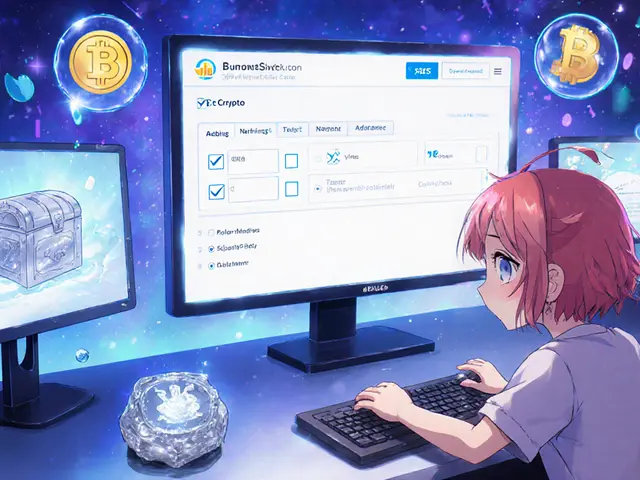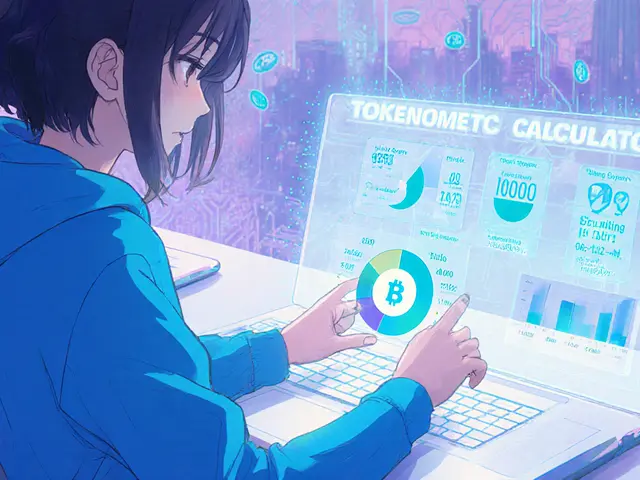ONT Staking Rewards Calculator
Estimate your potential earnings from staking ONT tokens.
When you see the name Ontology (ONT) is a high‑performance blockchain platform that focuses on decentralized identity and data management. It was launched by the Chinese company OnChain in 2017, the same team behind NEO. If you’re wondering what the Ontology (ONT) crypto coin actually does, this guide breaks it down in plain English.
Quick Summary
- Ontology is an enterprise‑focused blockchain with a dual‑token model: ONT for governance, ONG for transactions.
- Founded by the creators of NEO, it launched its own mainnet in 2018.
- Uses Proof‑of‑Stake consensus, achieving block times of 1‑30 seconds.
- Targets businesses needing decentralized identity, not just retail traders.
What Is Ontology (ONT)?
Ontology (ONT) is the native governance token of the Ontology blockchain. It enables token‑holders to vote on network upgrades, stake for network security, and participate in decentralized identity protocols. The platform’s open‑source code lets companies build private or public blockchains without rewriting their whole IT stack.
Key milestones:
- 2017 - Project announced by Erik Zhang and Da Hongfei, co‑founders of NEO.
- June 2018 - Migration from the Neo test‑net to Ontology’s own mainnet.
- 2020‑2024 - Series of upgrades aimed at cross‑chain interoperability.
Dual‑Token System: ONT vs ONG
The Ontology network runs two tokens: ONT and ONG. ONT is the governance token, while ONG pays for transaction fees and smart‑contract execution.
| Attribute | ONT | ONG |
|---|---|---|
| Purpose | Governance, staking, voting | Transaction fees, smart‑contract execution |
| Supply cap | 1billion | Inflationary (generated per block) |
| Earned by | Staking ONT | Staking rewards, block confirmation |
| Ticker | ONT | ONG |
When you lock ONT in a staking contract, the network mints ONG and distributes it as a reward. This design keeps the governance token scarce while providing a steady flow of utility tokens for developers.
Technical Architecture
Ontology’s backbone is a modular framework supporting both public and permissioned blockchains. It relies on Proof‑of‑Stake (PoS) consensus, which lets validators secure the network by staking ONT instead of using energy‑intensive mining.
Key technical specs:
- Block time: 1‑30seconds, giving near‑instant finality.
- Interoperability: Bridges to Ethereum, EOS, QTUM, and NEO.
- Smart‑contract language: Supports Go, C#, and Java, easing enterprise adoption.
Because the platform can run private side‑chains, businesses can keep sensitive data off public ledgers while still benefiting from Ontology’s identity layer.
In the enterprise space, Ontology sits next to solutions such as Hyperledger Fabric and R3 Corda, while on the public side it competes with Bitcoin and Ethereum for developer attention.

Enterprise Use Cases
Ontology’s primary value proposition is decentralized identity (DID). Companies can issue verifiable credentials-like a digital passport or academic certificate-that are tamper‑proof and instantly searchable.
Typical scenarios:
- Supply‑chain tracing: A logistics firm records every hand‑off on the blockchain, giving retailers real‑time provenance.
- Financial KYC/AML: Banks verify customer identities once on Ontology and reuse the credential across partners.
- IoT device authentication: Manufacturers assign each device a unique DID, preventing spoofing.
Compared with general‑purpose platforms like Ethereum, Ontology offers built‑in identity modules, reducing development time and cost for enterprises.
Staking and Rewards
Staking is the main way retail users earn on‑chain income. The process works like this:
- Transfer ONT to a staking contract or a supported wallet.
- Select a voting cycle (16hours to 20days).
- Lock ONT; the network automatically generates ONG each block.
- At the end of the cycle, receive ONG in your wallet.
Historical ROI figures are eye‑catching: Since its 2017 ICO‑equivalent price, ONT has delivered roughly 260% return in USD and nearly 500% in BTC terms. However, rewards are paid in ONG, so the value you receive depends on ONG’s market price.
Market Performance and Outlook
As of September2025, ONT trades around $0.117USD and sits near rank#345 by market cap. With a circulating supply of ~900million, the token’s scarcity is moderate. The dual‑token model provides a sustainable incentive structure, but price growth hinges on real‑world business adoption.
Strengths:
- Strong founding team with a proven track record (NEO).
- Clear enterprise focus and a growing list of Chinese partners.
- Active cross‑chain development.
Weaknesses:
- Limited presence outside Asia.
- Smaller developer ecosystem compared to Ethereum or Binance Smart Chain.
- Regulatory uncertainty in China could affect future funding.
Analysts expect the enterprise blockchain market to expand from $11.5billion in 2022 to over $160billion by 2029. If Ontology can capture even a fraction of that growth, demand for ONT and ONG could rise dramatically.
How to Acquire and Store ONT
Buying ONT is straightforward on most major exchanges. Here’s a quick checklist:
- Register on a reputable exchange (e.g., Binance, Huobi, or OKX).
- Complete KYC verification.
- Deposit fiat or crypto, then place a market or limit order for ONT.
- Transfer the tokens to a secure wallet that supports Ontology. Popular choices include the Ontology Desktop Wallet, Trust Wallet, and Ledger hardware wallets (via the Ontology app).
Always enable two‑factor authentication and store your private keys offline if you plan to stake.
Frequently Asked Questions
What is the difference between ONT and ONG?
ONT is the governance token used for staking, voting, and network upgrades. ONG is the utility token generated as a reward for block creation and pays for transaction fees and smart‑contract execution.
Can I stake ONT on a hardware wallet?
Yes. Ledger and Trezor support Ontology staking through the official Ontology app. You’ll need to connect the hardware wallet to a compatible staking interface.
Is Ontology suitable for NFT projects?
Ontology can host NFTs, but its ecosystem is optimized for identity and data services. Most NFT creators prefer Ethereum or Polygon for larger marketplaces.
How does Ontology achieve cross‑chain compatibility?
Through a set of bridge protocols and the Ontology Interoperability Framework, which translates transaction data between Ontology and other chains like Ethereum, EOS, and NEO.
What are the risks of investing in ONT?
Key risks include regulatory changes in China, limited adoption outside enterprise settings, and competition from larger blockchain platforms that also target identity solutions.
Whether you’re an investor, a developer, or a business looking for a blockchain identity layer, Ontology offers a niche but powerful set of tools. Understanding the token mechanics, staking rewards, and real‑world use cases will help you decide if ONT belongs in your crypto portfolio.







Comments
Carl Robertson
April 1, 2025 AT 03:38 AMONT is just another overhyped token riding the crypto hype train.
Rajini N
April 8, 2025 AT 08:46 AMActually, Ontology aims to provide a high‑performance public blockchain with a robust identity framework. Its native token, ONT, is used for staking, governance, and as a utility token within the ecosystem. Staking rewards are calculated based on the amount locked and the chosen period, which can range from a few hours to several months. The network’s dual‑token model (ONT and ONG) also separates transaction fees from governance, giving users more flexibility. So while hype exists, there’s genuine technical groundwork underneath.
Oreoluwa Towoju
April 15, 2025 AT 13:55 PMStaking ONT feels like a low‑effort way to earn a bit of passive crypto, but you still need to understand the lock‑up periods.
Jason Brittin
April 22, 2025 AT 19:04 PMOh great, another calculator that promises “estimate your potential earnings” like it’s a fortune‑telling crystal ball. 🙄
Amie Wilensky
April 30, 2025 AT 00:12 AMIndeed, the ONT staking rewards calculator-while aesthetically pleasing-does not magically conjure profit; it merely projects possible outcomes based on your inputs, which, if entered incorrectly, could lead to misleading figures, so double‑check your numbers; remember that network inflation, transaction volume, and varying reward rates also play pivotal roles. Moreover, the tool assumes a static reward rate, ignoring potential protocol upgrades that could recalibrate incentives. Users often overlook the fact that the staking period selection-whether 16 hours or 1 month-affects not only the reward magnitude but also liquidity constraints. Additionally, gas fees and transaction costs, though minimal on Ontology, still erode net returns, especially for smaller stakes. Finally, while the calculator provides a convenient interface, it should be complemented with thorough research, community discussions, and an awareness of market volatility. In sum, treat the calculator as a rough guide, not a definitive financial forecast.
Clint Barnett
May 7, 2025 AT 05:21 AMWhen you dive into the world of Ontology, you quickly realize that it’s not just another run‑of‑the‑mill blockchain project; it’s a sprawling ecosystem that attempts to marry identity verification with data sharing in a decentralized fashion. The architecture is built on a dual‑token system: ONT serves as a governance and staking instrument, while ONG (the Ontology Gas) powers transaction fees, creating a separation of duties that many blockchains lack. Staking ONT can be likened to planting a seed that sprouts over time, yielding periodic rewards that are paid out in ONG-think of it as earning interest in a different currency. The staking periods offered range from a brief 16‑hour window, which caters to those seeking quick liquidity, up to a month‑long commitment that boosts the annualized yield. However, the longer you lock your tokens, the higher the risk you assume, especially if market conditions shift dramatically. The calculator embedded in the article attempts to demystify these variables, allowing you to input your stake amount and desired period to see a projected reward. While the numbers it spits out are mathematically sound, they’re built on assumptions about network activity and reward schedules that could change without notice. Therefore, it’s prudent to treat these estimates as a baseline rather than a guarantee. If you’re comfortable with the underlying technology and the potential upside, staking can be a relatively low‑effort way to augment your portfolio. Conversely, if you’re risk‑averse, you might prefer to keep your ONT liquid and explore other avenues within the Ontology ecosystem, such as participating in dApps or contributing to governance proposals.
Jacob Anderson
May 14, 2025 AT 10:29 AMSure, “low‑effort” until the market decides otherwise.
Kate Nicholls
May 21, 2025 AT 15:38 PMReading through the ONT overview, it becomes apparent that the project’s marketing outpaces its tangible adoption. While the tech stack is respectable, real‑world partnerships are still in infancy. Staking rewards look attractive on paper, but they’re heavily contingent on network usage. Prospective investors should weigh the hype against concrete utility.
MD Razu
May 28, 2025 AT 20:46 PMOne could argue that the dichotomy between marketing flamboyance and genuine utility is a microcosm of the broader cryptocurrency narrative, wherein perception often masquerades as progress. Ontology’s ambition to fuse identity with data exchange is philosophically resonant, yet execution remains a litmus test. The staking mechanism, while mathematically elegant, serves as a veneer that may conceal underlying scalability constraints. Moreover, the dual‑token paradigm, though innovative, introduces complexity that can deter casual participants. In assessing ONT, we must therefore adopt a dual lens: one that scrutinizes technical merits and another that gauges community traction. Historical precedence suggests that projects with robust developer ecosystems tend to weather market turbulence better than those reliant on marketing sheen. Consequently, a discerning investor would allocate capital proportionally to demonstrated adoption metrics rather than projected yields alone. Ultimately, the value proposition hinges on whether Ontology can transition from theoretical constructs to pervasive real‑world applications.
Charles Banks Jr.
June 5, 2025 AT 01:55 AMAlright folks, let’s cut the fluff: if you’re just looking for a shiny new token to toss into a staking pool, ONT might be your weekend hobby. The calculator’s UI is slick, but remember it’s only as good as the data you feed it-no crystal ball here. If you’re into identity solutions, Ontology has some legs, but the ecosystem is still a toddler compared to Ethereum’s playground. Also, staking rewards fluctuate, so don’t expect a steady paycheck. Bottom line: do your homework, or you’ll end up with a digital paperweight.
Ben Dwyer
June 12, 2025 AT 07:03 AMGood points! It’s always wise to research before committing any funds.
Lindsay Miller
June 19, 2025 AT 12:12 PMI understand the confusion around crypto staking; it can feel overwhelming at first, but breaking it down step by step helps.
Katrinka Scribner
June 26, 2025 AT 17:21 PMOMG this ONT thing is soooo cool!! 🎉 I love the idea of earning while you sleep, like crypto magic! 😍
Waynne Kilian
July 3, 2025 AT 22:29 PMYea, it’s fun to think about passive earnings, but let’s stay realistic and remember the market can be tricky.
Naomi Snelling
July 11, 2025 AT 03:38 AMThere's a good chance the ONT token is being used as a testing ground for a larger, more covert data collection scheme. The whole identity framework that Ontology touts is just a polite way of saying they want to map every user's digital footprint. If you look at the partnerships they announce, many of them are with obscure firms that rarely show up in mainstream press. Those companies are often subsidiaries of bigger conglomerates that have vested interests in surveillance technology. Staking rewards look generous, but they serve as a sweetener to lure unsuspecting investors into the system. Once your ONT is locked, the protocol gains control over a slice of your future transaction fees, effectively siphoning value. The calculator on the site is intentionally opaque, hiding the exact formulas to keep the average user in the dark. Meanwhile, the ONT developers keep pushing updates that subtly shift the reward algorithms without clear disclosure. The dual‑token model, with ONT and ONG, is a clever way to separate governance from utility while still harvesting data. Every time a transaction occurs, metadata is recorded and can be aggregated across the network. In the hands of the right actors, that aggregated data becomes a goldmine for targeted advertising and influence. What’s more, the regulatory environment for such data collection is still fuzzy, giving projects like Ontology room to operate unchecked. If the community isn’t vigilant, this could set a precedent for other blockchains to follow the same playbook. So while the surface looks like a legit staking platform, the underlying motives might be far more sinister. Stay cautious, read the fine print, and don’t let the promise of passive income blind you to the bigger picture.